














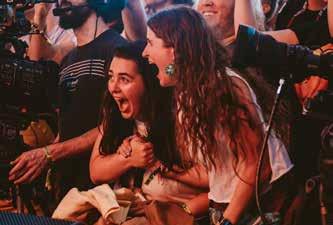


COREY BOSTON corey@townepost.com (502) 407-0185
CURTIS CARMAN JULIE ENGELHARDT MELISSA GIBSON
GAVIN LAPAILLE
DAVE MATHEIS
MELISSA STALB
BETH WILDER
TOWNE POST NETWORK, INC. FOUNDER, CEO TOM BRITT tom@townepost.com (317) 496-3599
PRESIDENT JEANNE BRITT jeanne@townepost.com (317) 810-0011
PRODUCTION COORDINATOR ERIN TURK
CREATIVE DIRECTORS VAL AUSTIN TONI EADS
DIRECTOR OF
DEVON DEAN COPY EDITOR JON SHOULDERS
TOWNE POST NETWORK, INC. 8800 North Street, Suite 117 Fishers, IN 46038 Phone/Text: (317) 810-0011

CONTACT








An unfortunate need in any community is a local funeral home. One of the earliest and best-known in Jeffersontown was the Myers & Blankenbaker Funeral Home, which was located on the town square at 10515 Watterson Trail, to the right of the building that houses Jeffersontown Hardware.
Fred Myers began his career in 1901, serving under C. Schildt & Sons of Louisville, and by 1907 he was established as a funeral director and embalmer in his own right, dubbing himself the successor to J.W. Shafar. By 1908, he had taken on N.R. Blankenbaker as partner, thus creating Myers & Blankenbaker. That same year, the two invested in an up-to-date hearse, which was pictured in their advertising at the time, and they were able to render the same
funerary services provided in larger cities.
As necessary as the funeral home was, that business alone was not enough to keep Fred Myers and Nat Blankenbaker as busy as they wanted to be. Both men were heavily involved in civic duties; Myers was for many years chief of the Jeffersontown Volunteer Fire Department, a trustee of the Jeffersontown cemetery, a Mason, and an active member of the Jeffersontown Christian Church, while Blankenbaker also served as a real estate agent in the firm Blankenbaker & Bowles.
Yet even that was not enough for these enterprising men. In addition to serving as a funeral home, complete with chapel, offices and stockroom, the building was loaned and sometimes rented as space for
various programs. More often than not, use of the building was provided for free as a civic service, so that other organizations and churches had a space to hold fundraisers, political rallies, community events and performances.
Some of the most interesting events held at the funeral home were the Myers & Blankenbaker Picture Shows. In the early 1900s moving pictures were a fairly new form of entertainment, but Myers & Blankenbaker showed them fairly regularly, and even had an electric piano that played during these shows. Admission was 10 cents for adults and 5 cents for children. The Boy Scouts often hosted these shows, while Myers & Blankenbaker allowed them to keep the proceeds and even paid for the advertisements. In a very interesting 1917

ad, Myers & Blankenbaker promoted both their automobile and horsedrawn hearses, along with their picture show.
But that was not all Myers & Blankenbaker did at the funeral home; they also sold cars. They were the county agents for Overland Automobiles, and their 1914 ad even states, “come in and see this car,” which suggests that at least one of the cars was actually at the funeral home. In 1915, even though

Burning, stinging, electricity like tingling pain in the hands and feet can really overpower your life if you experience it. Some people call it neuropathy some people call it damage. Regardless, nerve inflammation is the underlying cause of it. At Modern Chiropractic, we have two treatments that have been successful in turning off the inflammation in the nerve and relieving your pain and getting your quality of life back.



other newspapers were reporting about hard times, The Jeffersonian stated that in two weeks, Myers & Blankenbaker had sold five or six cars. They even opened a branch office at Middletown, where in addition to funeral services, their ad states they were also agents for McCormick mowers, tractors, binders and rakes.
After the death of Blankenbaker, Myers was in the business on his own again, offering both funeral home and ambulance services for Jeffersontown and Middletown. Fred Myers passed away in 1950, and in 1955 Barry and Charles Foreman obtained interest in the funeral home from one of Myers’ grandsons, Fred Roemele. In 1958 they purchased the remaining interest from his brother, Lloyd Roemele. Foreman Funeral home remained in the building until 1963, when it moved to its new location at 10600 Taylorsville Road, now the site of Ratterman Funeral Home.



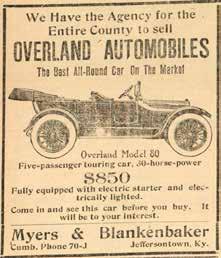

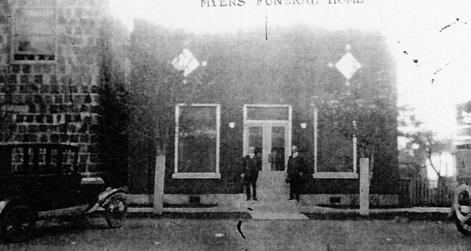







Did you have a dollhouse when you were little?
Remember the intricate pieces of a tiny old-fashioned kitchen, positioning each doll in the living room, or preparing the “little ones” for bed?
Perhaps dad or grandpa hand-crafted some of the little wooden furniture or mom sewed clothing for the dolls. It was a world of imagination and a product that kept children engaged for hours.
Since 1973, the Louisville Miniature Club (LMC) has brought a passion for all things miniature to the community with that same

magic and imagination from youth.
After submitting two miniature scenes for a national doll show and winning two blue ribbons, Founder Janette Hutchison began posting signs inside grocery stores and businesses in Louisville looking for interested collectors in the community.
The first meeting of the LMC brought together seven people who also loved creating, collecting and sharing their passion.
At the time, collecting miniatures was in the top-three hobbies in the country. Popularity has waned over the decades, but today it’s
experiencing a resurgence across the globe.
Chances are, you’ve seen the LMC before. Today the club consists of approximately 30 members and they are very active in the community. They attend school functions, the State Fair and Girl Scout activities. Since 2014 they’ve filled both display cases at the Bon Air branch of the Louisville Free Public Library with miniatures for an annual exhibit.
Nancye Johnson joined the LMC in 2008 and has served as club president since 2009. In addition, she serves on the board of the National Association of Miniature Enthusiasts (N.A.M.E.), headquartered in
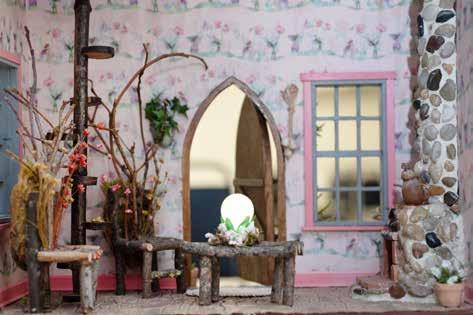

Carmel, Indiana.
“I’ve always loved dollhouses,” Johnson said. “As a kid I had a heavy cardboard house and one made of tin too. There’s a wide variety from kid-friendly to really high-end collectable dollhouses. I started out with a nice house and furniture, but at this point I’m running out of room and just looking for those one-of-a-kind pieces.”
What’s the attraction to miniatures?

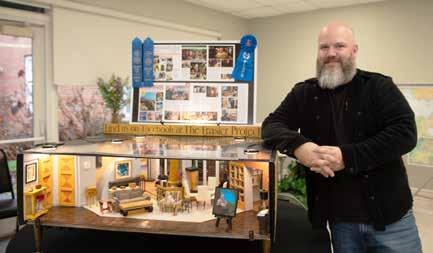
Some members enjoy collecting the tiny figures, others enjoy making them, and there’s also the social aspect of joining together with like-minded collectors and makers for projects, group activities and sharing with the community.
As with most collector items, the quality and price varies, but in miniatures, size varies as well, based on the collector’s preference. Miniatures come in 1 inch, half scale, quarter scale, and micro mini, making
no two collections identical.
Johnson described a miniature Dutch kitchen she created, which underscores the intricate detail involved.
“I have a piece that is 2 inches by 2 inches, and the furniture and kitchenware in the kitchen are made of paper because they are so tiny,” Johnson said. “You need good lighting and a magnifying glass to catch all of the detail in that piece.”

Some pieces are made of paper while others are carved from wood, and even now the club is seeing pieces created with 3D printing and laser cutting.
Some collectors prefer holiday decorative pieces, creating Christmas-themed displays, while others go with a specific character or era.
Take the YouTube sensation Ara Bentley, for instance, and her creation of a threestory “Addams Family” home. After nearly 10 years Bentley unveiled her 16-room mansion, complete with authentic miniature characters and room decor, and received worldwide recognition and appreciation for her masterpiece.
N.A.M.E. serves as a one-stop shop for event promotion and help with finding local clubs. Memberships are available, even a six-magazine subscription for enthusiasts to keep up on trends, news and more.
The world is watching, with interest shared
across the globe and groups coming from overseas to attend vendor shows in Chicago, St. Louis or Indianapolis to name a few.
“We have our own show in October each year,” Johnson said. “We bring in vendors from all over and have more than 200 people walk through, which is a pretty good crowd.”
Miniature museums are once again becoming popular and visitors flock to display locations across the country. Kentucky is home to The Great American Dollhouse Museum in Danville and the Kathleen Savage Browning Miniatures Collection in Maysville.
Johnson said whether visiting a museum or vendor show, once or repeatedly, each experience allows the viewer to discover something new or something they had not noticed before, and that’s one reason so many continue to come back.
The LMC meets at 2 p.m. on the first and
third Sunday of each month. Gatherings consist of a short business meeting, discussion of upcoming events and other needs, and then work on their current project, as well as gleaning information and advice from fellow club members and continuing to build their collections.
It takes different passions and skill sets for the club members to be as active as they are. Some enjoy creating or painting the pieces, and others like to do the needlework necessary for clothing and other fabrics in the miniature display. Learning a new technique from a club member or guest speaker helps to up their game and improve upon current and future projects.
“The club is like my second family,” Johnson said. “We go on retreats and bring extra projects to work on. It’s fun to do things with people who love what you do.”
It’s fun for the individual, but even more importantly, Johnson said the club mission



is to share miniatures as often as possible.
“At the State Fair we always have a Make Your Own Miniature project,” Johnson said. “We’ve made miniature corn dogs, cotton candy, an ear of corn, etcetera, and kids and adults really enjoy it. For the 50th anniversary celebration of the local Girl Scouts, we’ll be making a Christmas tree or winter scene in a cigar box. Once we attended a middle school math class to learn about scale.”
They keep up on recent trends and are constantly looking for new ways to entice young people to get involved. For example, a new miniature trend includes scenes inside a teacup and just may appear at an LMC event in the future.
Not only is it important to share the passion with others, but it’s also a skill and hobby Johnson hopes to pass on to a younger generation, particularly her six grandchildren. Her late husband
built dollhouses for each of the three granddaughters and she imagines her collection will eventually be passed on to them. Time will tell, but one of them might catch the bug that Johnson has so enjoyed.
“It’s a passion of mine,” she said. “When you retire, it’s a great way to keep your mind going and it keeps me busy. I love to go to the shows and the museums. They are just fascinating.”
The LMC members are always looking for new members to join, and invite residents from Louisville and surrounding areas to stop in for a meeting. Dues for the Louisville club are $24 annually, and include a T-shirt and name tag if a visitor wishes to join. The LMC is also affiliated with the national N.A.M.E. club, with access to additional events and information.
For more details on events and an LMC meeting schedule, visit thelouisvilleminiatureclub.org.







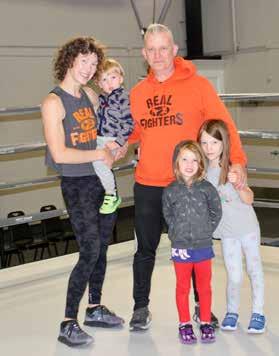

Eric Haycraft of Real Fighters Gym knows what it takes to become a professional kickboxer, and today he’s working to bring that knowledge and competitive edge to youth in Kentucky.
“It was my sophomore year of high school, and a friend and I kind of found this by accident,” Haycraft said. “We were skinny, runty kids going through awkward teenage stuff and we decided we should lift weights in my friend’s garage.”

From the small television in the garage, the boys saw a movie starring Jean-Claude Van Damme and knew the martial artist’s physique was exactly how they wanted to look. Coincidently, one of Haycraft’s friends found a kung fu club in the area and the group of teens joined the club. They bought uniforms and began taking weekly classes. Two months later, Haycraft was the only one still attending the class.
“I kind of got obsessed with it,” Haycraft
said. “I loved the sparring aspect of it and I thought I was good.”
Several years later he found a kickboxing gym in southern Indiana and enrolled, believing he had what it took to move to the next level.
“The coach put me in the ring with some boxing gloves, and a 115-pound kid comes in and beats the snot out of me,” Haycraft said. “I was shell-shocked. It was a serious
ego check. I felt like I had spent years learning to fight for nothing. I really needed to shift gears to the sport side of things, versus the cultural side of things you see in traditional martial arts.”
He began collecting VHS tapes of professional kickboxing fights, and discovered stars like Ramon Dekkers, a professional kickboxer and eight-time Muay Thai world champion. Haycraft reached out to Dekkers’ trainers in the Netherlands and inquired about training with them.
In 1994 he made his first trip to the Netherlands, and was hooked.
“I loved the training, the ideology, the professionalism and the popularity of the sport there,” he said. “I went for two weeks and extended my stay for another two weeks just to be able to learn more. I developed an amazing relationship with the whole team, and since then I’ve been there 40 or so times.”
Though he had found his passion, limits in the United States would hinder Haycraft’s dream of becoming a world champion.
“We didn’t have that infrastructure here for world-champion levels,” he said. “There were no amateur tournaments then. I don’t think I ever said it out loud, but my subconscious knew I was unlikely to become a world champion. What I could do was get the ball rolling to create it for someone else’s future.”
That’s just what Haycraft has done, essentially making it legal in the state of Kentucky to host competitive kickboxing events, and watching youths from his boxing gym soar to new levels.
Real Fighters Gym, the latest incarnation of Haycraft’s program, opened in 2009. While it is a full-on kickboxing gym, most of the participants are training for recreational purposes. Regardless of intent, be it fitness or competition, the programs push everyone to give their all and become a lot more than they realized
they could.
“Prior to COVID, we were producing some of the top athletes in the U.S. right here in Louisville without ever fighting in Louisville,” Haycraft said. “We couldn’t compete in this state, but yet we’re sending our athletes all over the world to compete.”
Lack of local access to competitions can
get expensive, and in addition, most of the competitors start a bit late in age, making it difficult to succeed at the highest levels.
“Think about children who have their sights set on the Olympics,” Haycraft said. “Whether it’s soccer or gymnastics, they didn’t start out at 22 years old. We had interested 20-somethings competing, but they’re moving on before they get a chance


to become world-level.”
Forced closures related to the pandemic hit Haycraft’s gym hard, along with so many other small businesses, but when they began to rebuild clientele, a new wave of younger athletes found them.
A few teens began attending the gym and telling their friends. A new competitive kickboxing population was born. But not without another hiccup.
Adult competitors can pay their way to amateur competitions. They often have jobs that allow them time off, like serving or bartending, making it easier to compete in matches across the country and the world. However, that often isn’t the case with teens depending on their parents’ funds and support.
“You’re looking at a mom with several kids and the first tournament is in Iowa,” Haycraft said. “She has to take off work and bring the whole
family to a hotel for five days so her kids can compete. It’s a massive challenge with younger athletes in the system.”
He contacted the Kentucky Boxing and Wrestling Commission in Frankfort and began the process of legalizing kickboxing competition in the state.
It took years to accomplish his goal, but eventually Haycraft was able to establish ways to license qualified officials, ensuring events are fair and safe. The commission adopted a set of modern rules and granted Haycraft professional license to host events in Kentucky. The first event was held in July of 2023, and the second, NEXT CHAMP II, was held December 3. They sold out both times, making it a success in financial terms - but more importantly, a success in building opportunities for local athletes and other amateur kickboxers across the country.
“We’re sort of propping up the entire region,” Haycraft said. “I have a handful of

athletes that are very promising and could be superstars, but I can’t develop them in a vacuum. For example, Megan Culver, one of our female athletes, has competed in both of our events thus far. To build her, we must find eight female fighters dedicated to the sport, ideally within drivable distance from Louisville. We want to grow all of these athletes at the same time. It makes for better rematches and serves the goal for everyone.”
He keeps in mind some of the challenges that come with younger athletes as well. Instead of creating events that require a teen to attend for several days, he’s cutting down on time and cost for all of them.
“In a traditional event, athletes weigh-in the day before,” Haycraft said. “Not only does that require coming in an extra day and staying at a hotel an extra night, it’s really unhealthy because they’ll dehydrate themselves to make them as light as possible for the weigh-in. We convinced the state to allow us to do same-day weigh-ins. We



eliminate the need to dehydrate, and they show up fit and ready to fight at their real weight - arrive at 2 p.m. on a Sunday and the first fight is at 5 p.m.”
If an athlete lives in Chicago, for example, they can make the drive, weigh-in, compete in the first fight of the night and drive back home,
greatly reducing the cost of travel and time.
The remaining 2024 events in Louisville will be held at The Jeffersonian on July 21, September 15 and December 1.
“This blueprint I have created for developing athletes was a result of all those trips to
Holland,” Haycraft said. “We know how to make the fighters, how to keep them, how to prepare them, and now we’re creating opportunities for them here at home.”
For more information, visit realfightersgym.com.



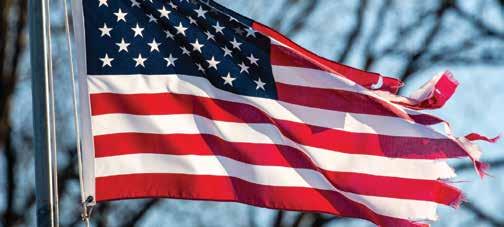


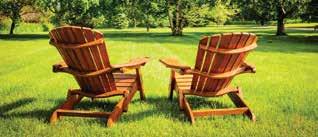

Feather holder?
Caterer’s dispenser
Bake sale offering
Hot spot
Amorphous mass
First name in spy fiction
Who or where follower
Browns
Fleet components
Crazily
Acquires
Palindromic title
Charge carrier
Bridge site
Fair feature
In addition
Wooden shoe
25. Mining finds
28. Clappers
30. Mall conveniences
31. Spar
32. On pins and needles
35. Songlike
38. Deep vein thrombosis (abbr.)
42. Ancient fabulist
44. Asia/Europe divider
45. Hoo-ha
46. Downtime
47. Like a crone
48. Pugilist’s weapon
51. Enough to tango
52. United
53. Turned on
54. Ang or Spike
ACROSS
1. Some trophies
5. Slant
9. Hit in the ring
12. “Carmen” selection
13. Poor, as excuses go
14. Outback runner
15. Pulmonary problem
17. Child occupier
18. Collar, as a perp
19. Puts on the line
21. Staff of life
24. Unexciting
26. Salad topper
27. Miles off
29. Application blank
33. Classified material?
34. “The Pirates of Penzance” heroine
36. Smidgen

37. Prepared to drive, with “up”
39. Curious, plus
40. “No ___”
41. Grand Canyon-esque
43. Out of practice
45. “Peter and the Wolf” bird
48. Oregon ___
49. Haul
50. Impassively
56. Start and end of the Three Musketeers’ motto
57. Has
58. In ___ of
59. Layer
60. Versifier
61. Kind of cell
Solution can be found on the magazine Facebook page
You’ve probably noticed the dollhouse-like buildings dotted throughout Louisville, perched upon posts situated in front of churches, schools, stores and even your neighbors’ homes. What are they, and why are they there? These whimsical structures are part of an international program called Little Free Library. The name says it all.
These tiny houses store all kinds of books for all ages. Patrons can pick up fiction books with genres that include fantasy, humor and real adventure, or nonfiction covering topics such as cooking, sewing, mechanics, fishing or travel. A library card is never required. The Little Free Library slogan is “Books are always free.”
The concept for the Little Free Library program began in 2009 in Hudson, Wisconsin. The first library was built by Todd Bol as an homage to his late mother, June Pattridge Bol, who was a teacher, librarian and
 Writer / Julie Engelhardt Photography Provided
Writer / Julie Engelhardt Photography Provided
avid book lover.
Domestically, Little Free Libraries can be found in all 50 states. Throughout the world, they are located in 91 countries and on all continents except Antarctica. Don’t be surprised if you take a journey to Argentina, Bermuda, China, Denmark, Taiwan or Zambia and see a Free Little Library. According to the official website, there are 150,000 Little Free Libraries worldwide.
Closer to home, one organization that’s instrumental in promoting the growth of these free book boxes is Metro United Way (MUW), specifically in neighborhoods on the west side of town. This effort began locally in 2014, thanks to resident Mary Sullivan, who was an MUW employee for 42 years. She now holds the honor of being the volunteer coordinator for donations and

distribution of books for MUW’s Little Free Libraries.
Sullivan’s involvement with Little Free Libraries happened somewhat by accident. She admits she really wasn’t one to surf the internet, especially during work hours, but one day a phrase online caught her eye: “If you’re interested in this, you may be interested in Little Free Libraries.” A post about the libraries explained that they provide an excellent way to distribute books into neighborhoods where there are no libraries, where the reading rate is low, or where there aren’t books in homes. It continued by saying that books in the home equal better reading skills, better grades and educational success.
One of Sullivan’s departments was volunteer engagement at MUW. She approached her boss about MUW participating in Little Free Libraries by reaching out to

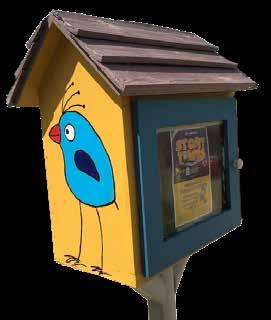

community groups to donate books or hold book drives. She explains that one of MUW’s goals is to improve the outcomes and reduce disparities for children from birth to age 5, and also create a healthy system and produce equitable outcomes for youth aged 6 to 24.
Sullivan’s boss gave her the green light. MUW began partnering with the Bingham Fellows program of the Leadership

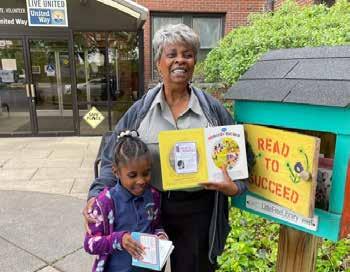
ground. That program’s leaders were looking at ways to become involved with programs that would benefit the neighborhoods west of 9th Street.
Gwen Kelly, a member of the team and a neighborhood advocate living in the 40210 zip code area, challenged the education team to bring 40 Little Free Libraries to that area. At that time, the 40210 area had the lowest reading rate for children attending
was granted permission from 15 homes and organizations to place libraries in what is known as the California neighborhood.
In October 2014, MUW held a workday at Victory Park to paint the libraries, but it was too cold and the ground was too hard to install them at the time, so they had to wait until the following spring to complete the project.


We test it out, make you an offer and CUT YOU A CHECK ON THE SPOT.
 Al, book volunteer deliverer
Grandmother Joanne and granddaughter
Al, book volunteer deliverer
Grandmother Joanne and granddaughter
MUW libraries are located in the 40202, 40203, 40208, 402111 and 40212 zip codes, which are in the Algonquin, Parkland, Portland, Shawnee and Smoketown/Shelby Park areas.
Currently MUW has 36 libraries. Each library receives between 45 and 50 books every two weeks. “We focus on placing in 15 books for children, which is about birth to second grade, 15 books for youth, which is mid-grade school to high school, and five to six books for adults,” Sullivan explains.
That comes to about 3,000 books per month placed in the libraries.
Book distribution is done with the help of loyal volunteers. There are six who go out on the biweekly run. They first make a stop at the MUW office to pick up boxes of books. The majority of the volunteers have five or six libraries to fill. One volunteer, Kathy Kremer, has eight libraries that she visits.
Kremer began volunteering with the program in 2015 when she heard about the libraries through her book-club cohorts.
“They sent word out that MUW was starting this Little Free Library project, and they needed volunteers to deliver the books,” she says. “I signed up because my parents were readers and they took us to the library. My aunt worked at the public library for 43 years. So it’s just a natural thing for me and I have an inclination to volunteer.”
Kremer goes on to explain that each library has a distinct personality of sorts.
“For example, one is in front of a Boys & Girls Club so I try to put all categories in there, because adults will have kids, and kids will have parents, and they all like to read,” she says. “I try to have a mixture of fiction and nonfiction adult and children’s books. Everyone has different tastes and they have different reading abilities, so trying to pack all of that into one little library is kind of a challenge.”
Kremer also services a Little Free Library in front of a middle school, and says that teachers have asked her to stock it with books that focus on careers. There’s another one in front of an apartment building for lower-income residents. “I’ve gotten requests for cookbooks and large-print material,” she says. “Another one is in front of a church, so I try to keep the books G rated.”
In 2023 Kremer received the WLKY Bell Award for her hard work and volunteer hours with the project, along with other volunteer work she does for the city.
Books are donated through a number avenues, by individuals, businesses and organizations.
“We’ve had books from retired teachers, and we get books from families who are moving,” Sullivan explains. “The Main Library and the Friends of the Library have


been a great resource. After their book sale last April, they donated 52 boxes of books to us. Those were the books that didn’t sell. Those books went into the little libraries that month and they were all probably gone by mid-June.”
Books-A-Million and Barnes & Noble have also been great supporters, as well as two young volunteers.
“One time we were really low on books, but there were two children, unbeknownst to



us, that held lemonade stands during the summer, and they had signs up saying that the money would go towards gift cards to buy books for the Little Free Libraries,” Sullivan says. “We received two gift cards for $100 each, and they were both for Books-AMillion.”
Little Free Libraries not associated with MUW can be found throughout the metro area, including Jeffersontown, Middletown and St. Matthews. Visit app.littlefreelibrary. org/ourmap and search for your area as well
as other locations.
If you are interested in volunteering with the MUW’s Little Free Library program, you can reach Mary Sullivan or Dulce Solorio at 502-583-2821. Sullivan’s email address is mschocchip@gmail.com, and Solorio’s address is dulce.solorio@metrounitedway.org.
You can also bring books to the MUW building at 334 East Broadway in Louisville, from 9 a.m. to 4:30 p.m. Monday through Friday.


















Photography Provided
Commonwealth Credit Union (CCU) has been supporting Kentucky families since 1951. With branches across central Kentucky and Louisville Metro, the CCU team takes pride in serving its members.
“We are all about bettering the lives of our members and their families,” said Glenn Griffin, CCU operations regional manager. “We are about financial empowerment and education. We want our members to understand what they’re doing and how it impacts their home and family.”
CCU offers a variety of financial services including savings, checking and retirement accounts, credit cards, and loans for home and auto. Membership is open to anyone who lives, works, worships, attends school or volunteers in 25 different Kentucky counties, including Jefferson, Bullitt, Oldham and Shelby.
“Commonwealth Credit Union has shown remarkable growth this year,” Griffin said. “Not only are we growing in the traditional
sense - member and asset growth - but we’re also growing in our knowledge base. This year we introduced a new operations training department, which has provided a consistent training plan for all front-line team members. We also continued to field feedback from our members and implement new initiatives where it makes the most strategic sense. Additionally, we rolled out new products such as Power Checking, Personal Goal Savings and, throughout the year, an array of Certificate Specials to help our members take advantage of the current interest rate environment. We also continue to offer a powerful home equity line of credit and other dynamic programs, like Full Home Lending.”
CCU is backed by the National Credit Union Administration, which federally insures savings to at least $250,000. CCU Certificates, IRAs, and Money Market accounts are also insured an additional $100,000 by the Excess Share Insurance Corporation. Griffin said everyone should feel secure having their money at CCU.
“We work continually to provide exceptional service, learn from our members
and implement their suggestions where applicable,” he said. “If it’s a suggestion we can’t implement, we provide them with the ‘why’ behind our decision-making process and help them understand our approach. Our Credit Union has been in business since 1951, and while that is a long time, we’re still growing and adapting to current technology, trends and member needs. We are excited to be part of an evolution much larger than ourselves.”
“We want to ensure we are offering what is beneficial to you and your family,” Griffin added. “We do a lot of giveback and love participating in every community we’re in. These are our homes and neighbors and friends. It’s a really unique experience to be part of a credit union. With our robust digital banking applications, we’re available to our members seven days a week. Stay tuned; the future is looking very exciting!”

Churchill Downs is not the only horse racing track that has called Louisville home. There have been as many as six others. Many longtime residents can probably name two: Miles Park and Louisville Downs. Miles Park opened at the site of the old Kentucky State Fairgrounds in the West End in 1956. Initially a standard-bred harness racing track, it quickly switched to thoroughbred racing two years later, and actually had a couple of quarter-horse race meets before closing in 1978. Louisville was a standard-
Writer / Dave Matheis Photography Providedbred harness racing track on Polar Level Road that operated from 1966 to 1991.
Lesser-known tracks were Elm Tree Garden, Oaklawn Race Course and Woodlawn Race Course. Elm Tree Garden was Louisville’s first amusement park. Located on Shippingport Island, it opened in 1829. The park included a racetrack. It closed in 1873. Oaklawn Race Course was located at 7th and Magnolia streets. It opened in 1832 and closed in the mid-1850s. Woodlawn Race
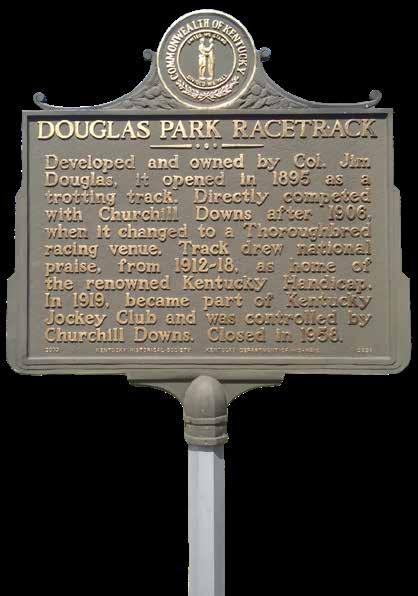
Course was located in far-eastern Jefferson County and operated from 1859 to 1870.
Douglas Park Racetrack had a longer history than any of those, existing from 1890 to 1958, although racing was only conducted during a small portion of that time. Located in the Beechmont neighborhood of south Louisville, Douglas Park Racetrack opened in 1890 as a standard-bred harness racing track. It was named for Colonel James Douglas, the original principal shareholder. Trotting races were held on the grounds until 1913, when the track changed to thoroughbred racing. Those races were only conducted there for five years. In 1918 the Kentucky Jockey Club purchased the 122 acres of Douglas Park and promptly discontinued racing. The Jockey Club began using the facility to stable and train horses for Churchill Downs.
One of the more famous temporary residents at Douglas Park was the horse Donerail. At the Kentucky Derby of 1913, the barns at Churchill Downs were overcrowded, so the connections of Donerail had to stable their horse at Douglas Park. He was walked the three miles to Churchill Downs on the day of the race. Despite the walk, Donerail won that Derby, becoming - and remaining todaythe biggest long shot to win in the history of the race.
The clubhouse and grandstand at Douglas Park were demolished in 1939. A series of damaging fires on the grounds started during the 1940s. In 1941 a fire destroyed one barn containing 11 stalls, but no horses were lost. Then, on New Year’s Eve in 1944, a large blaze destroyed another barn, killing a 77-year-old track attendant, nine racehorses and a track dog in the process. A smaller fire occurred in April of 1948.
Churchill Downs overhauled and improved the facility in 1950. In the same year, the Downs sold 21 acres of the property to the Archdiocese of Louisville. Later, a new church, St. John Vianney, was built on part of those 21 acres. Fire struck again in March of 1951.
This was only a prelude to a major fire that occurred on October 26, 1952. A large barn, reportedly one of the largest horse barns in the world, was destroyed. Sixty-eight thoroughbreds were killed.
That fire created quite a stir in the surrounding area. A fireman on the scene told the Courier-Journal the resulting crowd of onlookers was the largest he had ever seen at a Louisville fire.
“I lived at Fifth and Denmark,” recalled Dave Puckett, a teenager at the time. “From our neighborhood we could see a big red glow the night it burned. First thing next morning, we jumped on our bikes and went there. What a stinking mess, smoldering hay, dead horses.”
“I was 2 years old at the time and vividly remember the sound of the horse hooves hitting the pavement on Amherst Avenue as the horses fled the fire,” said Roger Burge. “Some of the fleeing horses were located as far away as National Turnpike.”

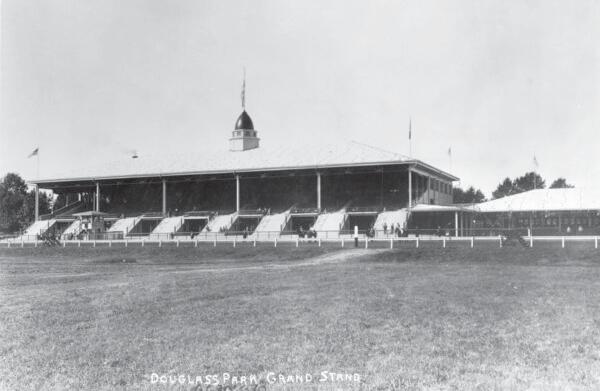




Louisville’s State Park is your natural escape for meetings and weddings, fun, sports, and trails. Peruse our diverse offerings at parks.ky.gov 3000 Freys Hill Rd, Louisville, KY 502-429-7270
“I was 4 and our young family lived in a second-story apartment near the fire station on Wellington,” said Pat Kincaid, another resident of the area at the time. “I remember my dad taking my 2-year-old sister and me out of the windows to sit on the roof, much to my mother’s chagrin. He tried to explain to us what was happening while we watched the flames rise high in the sky and listened to the sounds of the chaos. I didn’t understand the scope of it at that age, but I sure remember those flames.”
“I was 10 years old and living in my grandmother’s house,” recalled Jack Clark. “We were sitting on the front porch. The sky was turning bright red and my grandmother, who was very religious, thought the world was coming to an end. Scared the devil out of me. I also remember seeing horses run down the middle of Second Street, some of them appearing to be badly hurt. A couple of them fell on the street and were screaming. It was very horrible. My dad went over there to see if he could help and
came back dirty, saying that he helped the firemen hump the hoses. I remember that fire well.”
“I can remember the fire,” said William Stovall. “My mother and aunt took my cousin and me there the next morning. Horses were lying around along with thousands of feet of hose. Twenty years later, I became a firefighter. Go figure. I guess it made a impression on me.”
Donnie Hardin’s father was a teenager. He and his friends saw the smoke and rushed over on their bikes. They saw horses running around screaming. The scene haunted his father until he died.
A 24-year-old exercise boy later confessed to deliberately starting the fire while under the influence of alcohol and marijuana, and was sentenced to five years in prison. He also admitted to accidentally setting the fire in March of 1951.


As successive fires plagued Douglas Park, Churchill Downs continued to sell off parcels of the property. In 1954 three acres were sold to George Gould for the construction of offices, and the Archdiocese purchased seven more acres for $28,000. This latter plot would become the site of Holy Rosary Academy, now the Americana Community Center.
Finally, at a meeting of the board of directors of Churchill Downs on June 5, 1956, the decision was made to liquidate the rest of the property. The board hoped to obtain a total of $1,000,000 for capital improvements at the Downs. The last horses left the grounds in July of the next year. The track surface was actually scraped off and deposited on the Churchill Downs racetrack. By the spring of 1958, the remaining 78 acres of Douglas Park were cleared of the last 10 barns, and the land was leveled and sowed with grass.












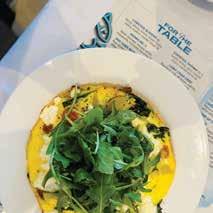



Celebrating its sixth installment, Bourbon & Beyond returns for its biggest year yet. Produced by Danny Wimmer Presents, the world’s largest bourbon and music festival is set to take the stage this September 19 through 22 at Highland Festival Grounds at the Kentucky Exposition Center. With two new music stages and 40 extra music acts for 2024, this expansion brings the total to five dynamic music stages hosting 100 talented artists, alongside captivating culinary and bourbon workshop stages, promising an unforgettable affair.
“Beyond the music, the festival has so many great experiences,” said Chamie McCurry, Chief Marketing Officer for Danny Wimmer Presents. “There is something
Story & Photography Providedfor everyone there. We will have some special programming and great partnership activations throughout the event. It’s an amazing festival experience from beginning to end.”
This year’s all-star lineup of music artists spans generations and genres, with legends Neil Young and Beck on Thursday, Dave Matthews Band and Tedeschi Trucks Band on Friday, Zach Bryan and Cody Jinks on Saturday, and Tyler Childers and My Morning Jacket on Sunday, along with Matchbox Twenty, The National, Whiskey Myers, Black Pumas, The War On Drugs, The Beach Boys, Mt. Joy, Fleet Foxes, Young the Giant, Maren Morris, The Head and the Heart, Melissa Etheridge, Teddy Swims, and
many more.
The festival attracts concertgoers from all over the world. Indeed, Bourbon & Beyond’s annual success has made it a can’tmiss event. Fans come from all 50 states and over 25 countries to Louisville for an unforgettable four-day journey filled with great music, tasty bourbon and renowned restaurant offerings.
Louisville is known for its southern hospitality. It’s where May is Kentucky Derby season, and now September has become festival season, stretching the city’s tourist season well into the fall. The tourism dollars generated from Bourbon & Beyond and Louder Than Life have made it a true

economic boon for the city that welcomes horse racing and sports fans.
Outside of the great music acts are the culinary experiences with Food Network stars and “Chopped” judges Amanda Freitag and Chris Santos, James Beard Award-winning Chef and Author Ed Lee, and Kroger’s Wine and Spirits Expert Chris Blandford. Each day will see bourbon panels, tastings and food demonstrations with artists, bourbon experts and celebrity chefs.
The music lineup at Bourbon & Beyond is extensive and spans generations of music. In fact, new acts are still being announced. Make plans today to attend this year’s festival, whether for a single day or the entire four-day lineup. It’s an adventure you won’t soon forget!













Zach Bryan, Dave Matthews Band, Tyler Childers, Neil Young, Beck, Matchbox Twenty, The National, My Morning Jacket, The War On Drugs, Whiskey Myers, Cody Jinks, Tedeschi Trucks Band, Black Pumas, The Beach Boys, Mt. Joy, Fleet Foxes, Young the Giant, Maren Morris, The Head and the Heart, Melissa Etheridge, Teddy Swims, Koe Wetzel, Milky Chance, The Red Clay Strays, Chris Isaak, Lyle Lovett, KALEO, Sierra Ferrell, Charles Wesley Godwin, Shane Smith & The Saints, The Wallflowers, Cory Wong, X Ambassadors, Sunny Day Real Estate, Dinosaur Jr., Larkin Poe, Bruce Hornsby & the Noisemakers, Lucius, JJ Grey & Mofro, Beth Hart, Allen Stone, Wilder Woods, Niko Moon, Molly Tuttle & Golden Highway, The War and Treaty, Ole 60, Larry Fleet, Josh Ritter & The Royal City Band, Mat Kearney, Arlo Parks, Hiss Golden Messenger, Smith & Myers, BRELAND, Patty Smyth, Wyatt Flores, Cimafunk, Futurebirds, The Bacon Brothers, M. Ward, Soul Asylum, Son Volt, Jade Bird, Neal Francis, Suzanne Vega, Wild Rivers, Dexter and The Moonrocks, KT Tunstall, The Dip, Meg Myers, Samantha Fish, Amigo the Devil, The Record Company, Taylor Acorn, Dan Tyminski, The Sam Bush Band, The Jerry Douglas Band, Yonder Mountain String Band, Tony Trischka’s EarlJam, Sister Sadie, Devon Gilfillian, Robert Finley, Abby Anderson, Abraham Alexander, Vincent Neil Emerson, Andy Frasco & The U.N Royel Otis., Mac Saturn, Jake Kohn, The Castellows, Madi Diaz, Motherfolk, Grace Bowers, Mapache, Maggie Antone, Briscoe, Duane Betts & Palmetto Motel, Hueston, Robert Jon & the Wreck, The Brothers Comatose, Theo Lawrence, Colby T. Helms and The Virginia Creepers, Nicholas Jamerson & The Morning Jays, New Dangerfield, Big Richard, Rob Ickes & Trey Hensley, Chatham County Line, Tray Wellington Band, The Kentucky Gentlemen, Lizzie No, The Jacob Jolliff Band, East Nash Grass, The Local Honeys, Mountain Grass Unit, Kaia Kater, The Last Revel, Kyle Ray and more.
“Our talent team prides itself on putting out the best lineup every year and being better than the year before,” McCurry said. “They have a lot of pride in curating that lineup specifically for the fans. We want to provide something new and something they love so people want to come back and experience it again.”
Passes are available to purchase at bourbonandbeyond.com and fans can lock them in as low as $10 down.
The weekend after Bourbon & Beyond, rock takes center stage for Louder Than Life, America’s biggest rock festival. With 140-plus bands over five stages, Louder will welcome Slipknot, Slayer, Motley Crue, Korn, Disturbed, Evanescence, Judas Priest and many more, September 26 through 29 at the same festival site.
Danny Wimmer Presents and the city of Louisville are ready to shine bright when they welcome the biggest eight days of music in the U.S., and host over 400,000 fans between the two festivals this September.

Expires 8/31/2024
Expires 8/31/2024
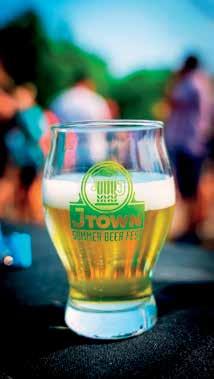





















Nature is great at providing moments of wonder, and in The Parklands we are getting a front-row seat to the transformation and migration of the monarch butterfly. This important pollinator species is endangered, and we at The Parklands are doing our part to change that. We actively support this species’ ability to thrive with the enhancement and protection of our meadow habitat that is specifically designed to attract and feed monarch butterflies.
Monarch caterpillars and eggs can only be found on one type of plant - the milkweed plant. Milkweed is the only host plant for these caterpillars and the only place an adult monarch will lay her eggs. Monarch eggs are laid directly on milkweed leaves so the newly hatched caterpillars can begin chomping away immediately.









Monarchs go through four phases in their lifetime - eggs, caterpillar, pupa and butterfly. Butterflies in these phases can be seen in our gardens and meadows right now. When the caterpillars grow large enough, they usually crawl away from the host plant to a more covered area to make their chrysalis. The entire process from egg to adult takes about four weeks. When these butterflies emerge from their chrysalises, they are part of a great migration from Canada to Mexico spanning over four generations.
Unfortunately, the monarch population has declined by about 90% in the last two decades, and we want to do everything we can to help protect them so they can thrive once again. This population decline is largely due to drought, habitat loss and pesticides, so protecting these monarchs and planting more of their host plant is integral to their survival.
At The Parklands, we are protecting and learning about monarchs by maintaining healthy meadows, and also participating in the Monarch Watch citizen science program and tagging our monarchs. The Monarch Watch Tagging Program began in 1992 to help better understand the dynamics of the monarchs’ spectacular fall migration through mark and recapture. Tagging helps answer questions about the origins of monarchs that reach Mexico, the timing and pace of the migration, mortality during the migration, and changes in geographic distribution. It also shows that the probability of reaching Mexico is related to geographic location and butterfly size.
To track monarchs, a tag is placed on each monarch butterfly caught during the migratory season. This small, sticker-like tag is lightweight and specifically designed to not interfere with the migration of the butterfly. Each tag has a unique code that can then be used to find out more information about each butterfly when they are retrieved in Mexico at their overwintering sites.
For more info on The Parklands, go to theparklands.org.













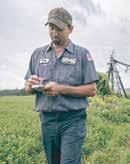


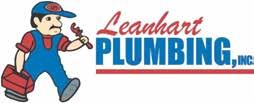











In a medical emergency, every second counts. That’s why UofL Health offers the most ER locations in the region with shorter wait times. And now, when you text ERWait to 511511 you can get a list of wait times at all 7 ER locations. We also have expert Urgent Care Plus centers nearby.
We offer safe, fast, compassionate care close to home. And we accept most insurances, including Medicare and Medicaid. So there’s never a reason to put your health on hold. That's the Power of U.
